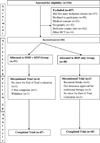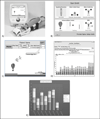The HAAPI (Home Arm Assistance Progression Initiative) Trial: A Novel Robotics Delivery Approach in Stroke Rehabilitation
- PMID: 25782693
- PMCID: PMC4573760
- DOI: 10.1177/1545968315575612
The HAAPI (Home Arm Assistance Progression Initiative) Trial: A Novel Robotics Delivery Approach in Stroke Rehabilitation
Abstract
Background: Geographical location, socioeconomic status, and logistics surrounding transportation impede access of poststroke individuals to comprehensive rehabilitative services. Robotic therapy may enhance telerehabilitation by delivering consistent and state-of-the art therapy while allowing remote monitoring and adjusting therapy for underserved populations. The Hand Mentor Pro (HMP) was incorporated within a home exercise program (HEP) to improve upper-extremity (UE) functional capabilities poststroke.
Objective: To determine the efficacy of a home-based telemonitored robotic-assisted therapy as part of a HEP compared with a dose-matched HEP-only intervention among individuals less than 6 months poststroke and characterized as underserved.
Methods: In this prospective, single-blinded, multisite, randomized controlled trial, 99 hemiparetic participants with limited access to UE rehabilitation were randomized to either (1) the experimental group, which received combined HEP and HMP for 3 h/d ×5 days ×8 weeks, or (2) the control group, which received HEP only at an identical dosage. Weekly communication between the supervising therapist and participant promoted compliance and progression of the HEP and HMP prescription. The Action Research Arm Test and Wolf Motor Function Test along with the Fugl-Meyer Assessment (UE) were primary and secondary outcome measures, respectively, undertaken before and after the interventions.
Results: Both groups demonstrated improvement across all UE outcomes.
Conclusions: Robotic + HEP and HEP only were both effectively delivered remotely. There was no difference between groups in change in motor function over time. Additional research is necessary to determine the appropriate dosage of HMP and HEP.
Trial registration: ClinicalTrials.gov NCT01144715.
Keywords: hemiparesis; robotics; stroke; telerehabilitation; therapy; upper extremity.
© The Author(s) 2015.
Figures


Similar articles
-
Incorporating robotic-assisted telerehabilitation in a home program to improve arm function following stroke.J Neurol Phys Ther. 2013 Sep;37(3):125-32. doi: 10.1097/NPT.0b013e31829fa808. J Neurol Phys Ther. 2013. PMID: 23872687 Free PMC article.
-
Three-dimensional, task-specific robot therapy of the arm after stroke: a multicentre, parallel-group randomised trial.Lancet Neurol. 2014 Feb;13(2):159-66. doi: 10.1016/S1474-4422(13)70305-3. Epub 2013 Dec 30. Lancet Neurol. 2014. PMID: 24382580 Clinical Trial.
-
Video Game Rehabilitation for Outpatient Stroke (VIGoROUS): protocol for a multi-center comparative effectiveness trial of in-home gamified constraint-induced movement therapy for rehabilitation of chronic upper extremity hemiparesis.BMC Neurol. 2017 Jun 8;17(1):109. doi: 10.1186/s12883-017-0888-0. BMC Neurol. 2017. PMID: 28595611 Free PMC article. Clinical Trial.
-
Effects of Robot-Assisted Therapy for the Upper Limb After Stroke.Neurorehabil Neural Repair. 2017 Feb;31(2):107-121. doi: 10.1177/1545968316666957. Epub 2016 Sep 24. Neurorehabil Neural Repair. 2017. PMID: 27597165 Review.
-
Aerobic exercise prior to task-specific training to improve poststroke motor function: A case series.Physiother Res Int. 2018 Apr;23(2):e1707. doi: 10.1002/pri.1707. Epub 2018 Feb 13. Physiother Res Int. 2018. PMID: 29436126 Review.
Cited by
-
A Stroke Rehabilitation Educational Program for Occupational Therapy Students and Practitioners: Usability Study.JMIR Med Educ. 2022 Sep 30;8(3):e35637. doi: 10.2196/35637. JMIR Med Educ. 2022. PMID: 36178717 Free PMC article.
-
Towards a Platform for Robot-Assisted Minimally-Supervised Therapy of Hand Function: Design and Pilot Usability Evaluation.Front Bioeng Biotechnol. 2021 Apr 15;9:652380. doi: 10.3389/fbioe.2021.652380. eCollection 2021. Front Bioeng Biotechnol. 2021. PMID: 33937218 Free PMC article.
-
Exoskeletons With Virtual Reality, Augmented Reality, and Gamification for Stroke Patients' Rehabilitation: Systematic Review.JMIR Rehabil Assist Technol. 2019 Sep 8;6(2):e12010. doi: 10.2196/12010. JMIR Rehabil Assist Technol. 2019. PMID: 31586360 Free PMC article.
-
Potential role of tele-rehabilitation to address barriers to implementation of physical therapy among West African stroke survivors: A cross-sectional survey.J Neurol Sci. 2017 Oct 15;381:203-208. doi: 10.1016/j.jns.2017.08.3265. Epub 2017 Sep 1. J Neurol Sci. 2017. PMID: 28991682 Free PMC article.
-
Robot-assisted distal training improves upper limb dexterity and function after stroke: a systematic review and meta-regression.Neurol Sci. 2022 Mar;43(3):1641-1657. doi: 10.1007/s10072-022-05913-3. Epub 2022 Jan 28. Neurol Sci. 2022. PMID: 35089447
References
-
- Kwakkel G, Kollen BJ, van der Grond J, Prevo AJ. Probability of regaining dexterity in the flaccid upper limb: impact of severity of paresis and time since onset in acute stroke. Stroke; a journal of cerebral circulation. 2003;34(9):2181–2186. - PubMed
-
- Ovbiagele B, Goldstein LB, Higashida RT, et al. Forecasting the future of stroke in the United States: a policy statement from the American Heart Association and American Stroke Association. Stroke; a journal of cerebral circulation. 2013;44(8):2361–2375. - PubMed
-
- Lloyd-Jones D, Adams R, Carnethon M, et al. Heart disease and stroke statistics--2009 update: a report from the American Heart Association Statistics Committee and Stroke Statistics Subcommittee. Circulation. 2009;119(3):480–486. - PubMed
Publication types
MeSH terms
Associated data
Grants and funding
LinkOut - more resources
Full Text Sources
Other Literature Sources
Medical

